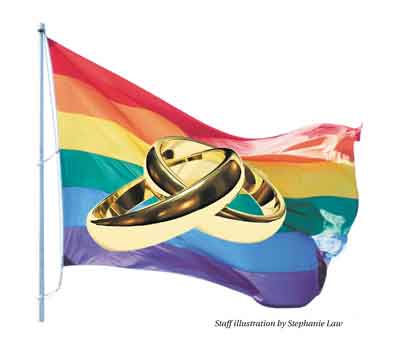On Nov. 4, 2009, a tearful crowd gathered on the steps of Portland City Hall, trying to come to terms with their disappointing loss in the state’s first same-sex marriage referendum.
They were told to keep on fighting for marriage equality, that history was on their side. The only way they could lose would be to quit. And they didn’t.
Just four years later, in November, a majority of the people of Maine approved a marriage equality law.
Until Wednesday, however, same-sex marriages were recognized only in Maine, 11 other states and the District of Columbia and by two Native American tribes.
Until Wednesday, the law of the land included the noxious federal Defense of Marriage Act of 1996, which defined marriage to mean a legal union only between one man and one woman.
On Wednesday, however, the U.S. Supreme Court issued rulings in two cases that had same-sex marriage at their core.
In the first, the court struck down the part of DOMA that prevented the federal government from recognizing the marriages of couples wed in states like Maine that do not discriminate.
The ruling affects more than 1,000 places in federal law where marital status matters, including the tax code, Social Security and immigration law. DOMA had kept legally married same-sex couples from receiving tax, health and pension benefits that are otherwise available to married couples.
The court did not find a constitutional right to marry, so same-sex couples living in states that do not recognize their marriages won’t benefit from this ruling. And Maine couples who think about moving to a state that does not recognize same-sex marriage will have to chose between moving and their rights. Neither situation is tolerable.
That, however, is a conversation for another day. Today, Mainers can think about what the ruling does accomplish.
It may not recognize a right to marry, but the majority opinion, written by Justice Anthony Kennedy, finds that the federal government does not have the right to force same-sex couples into a “second-tier marriage.” The distinction “demeans the couples,” the opinion said, “and it humiliates tens of thousands of children now being raised by same-sex couples.”
“The law in question makes it even more difficult for the children to understand the integrity and closeness of their own family and its concord with other families in their community and in their daily lives,” he wrote.
The second case, dealing with California’s constitutional ban on same-sex marriage, was resolved on a technicality that said nothing about gay marriage. The effect, however, was to leave in place a lower court ruling that the state’s Proposition 8 ban was unconstitutional.
Marriages of gay couples, briefly legal in 2008, likely will resume in about a month, as soon as a federal appeals court lifts its hold on the lower court ruling. That would make California the 13th state to allow same-sex couples to marry and would raise the share of the U.S. population in gay marriage states to 30 percent.
The tide of public opinion toward acceptance of same-sex marriage has risen greatly in the last four yours, with everyone from President Barack Obama to former Vice President Dick Cheney agreeing that the government should not punish people because of whom they love.
And now the highest court in the land has issued a pair of opinions that puts full equality for same-sex couples within reach.
A lot of work still must be done to achieve equal rights for lesbian, gay, bisexual and transgender Americans, and just like the crowd outside City Hall four years ago, they should not give up.
Wednesday’s rulings were major milestones in this civil rights struggle, and one worth celebrating.
Send questions/comments to the editors.



Success. Please wait for the page to reload. If the page does not reload within 5 seconds, please refresh the page.
Enter your email and password to access comments.
Hi, to comment on stories you must . This profile is in addition to your subscription and website login.
Already have a commenting profile? .
Invalid username/password.
Please check your email to confirm and complete your registration.
Only subscribers are eligible to post comments. Please subscribe or login first for digital access. Here’s why.
Use the form below to reset your password. When you've submitted your account email, we will send an email with a reset code.